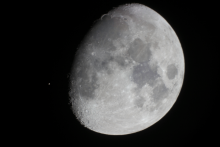Listen to today's episode of StarDate on the web the same day it airs in high-quality streaming audio without any extra ads or announcements. Choose a $8 one-month pass, or listen every day for a year for just $30.
You are here
Venus and Aldebaran
A brilliant point of light in the western evening sky is sweeping past one that’s merely bright.
The brilliant light is Venus, the “evening star.” It’s the brightest object in the night sky other than the Moon, so you can’t miss it. Despite its nickname, though, it’s not a star at all — it’s a planet. It’s the closest planet to Earth. And in some ways, it’s a near twin to our world. It’s about the same size, and it probably has a similar composition — a rocky crust and mantle around a dense core made of metal.
In other ways, though, Venus is quite different. Its atmosphere is far hotter and denser than Earth’s. And it’s topped by an unbroken layer of clouds made of sulfuric acid.
The merely bright light is Aldebaran, the ruddy eye of Taurus, the bull. It’s off to the left of Venus. And for the next two or three nights, it’s a little higher in the sky.
Aldebaran looks less impressive than Venus, but that’s an illusion — a result of its great distance. Instead, it’s a giant star — dozens of times the diameter of the Sun. If it took the Sun’s place, it would incinerate Venus and turn Earth into a burned-out cinder.
Watch Aldebaran and Venus over the next few nights. They’ll stand at about the same height on Wednesday or Thursday, depending on your latitude, before Venus pulls away. They’ll vanish from the evening sky later in the spring, then re-emerge in the morning sky — much closer together than they are now — in early July.
Script by Damond Benningfield




